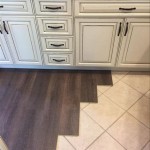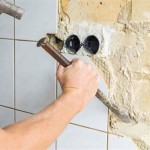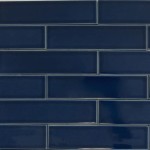Can You Put Flooring Over Ceramic Tile In Bathroom Floor?
The question of whether new flooring can be installed over existing ceramic tile in a bathroom is a common one for homeowners considering a renovation. The decision has several facets, including cost savings, time efficiency, and the potential impact on the bathroom's overall structure and functionality. Assessing the existing tile, subfloor conditions, and the compatibility of the new flooring material are critical steps in determining the feasibility and long-term success of this type of installation.
Installing new flooring directly over existing tile can potentially reduce labor costs and the disruptive mess associated with tile removal. However, without proper preparation and material selection, it can also lead to issues such as uneven surfaces, moisture problems, and reduced lifespan of the new flooring. Therefore, a comprehensive understanding of the involved factors is essential before proceeding with the project.
This article will explore the conditions under which installing flooring over ceramic tile is possible, the necessary preparation steps, suitable flooring materials, and potential pitfalls to avoid. It offers a detailed guide to help homeowners make an informed decision about their bathroom flooring renovation.
Evaluating the Existing Ceramic Tile
Before considering any type of flooring installation over existing ceramic tile, a thorough inspection of the tile itself is mandatory. The state of the existing tile directly impacts the success of the new flooring layer. Several aspects should be carefully considered.
First, the evenness of the existing tile surface must be examined. Significant variations in height between tiles or individual tiles that are raised or sunken will create an uneven subfloor. This unevenness will telegraph through to the new flooring, potentially making it aesthetically unappealing and structurally unsound. Small variations can sometimes be mitigated with leveling compounds; however, large discrepancies may necessitate tile removal. A long level or straight edge can be used to identify these inconsistencies.
Second, the condition of the grout lines should be evaluated. Deep or wide grout lines can also contribute to an uneven surface. Filling these grout lines with a cement-based patching compound is generally recommended to create a smooth and stable base. The patching compound should be allowed to fully cure before proceeding.
Third, the presence of loose, cracked, or damaged tiles is a critical concern. Any loose tiles should be re-adhered to the subfloor, and cracked or damaged tiles should be replaced. Failure to address these issues will undermine the structural integrity of the new flooring. Attempting to install new flooring over unstable tiles will likely result in premature failure of the new layer.
Finally, consider the overall stability of the existing tile installation. Check for any signs of movement or flexing when walking across the tile. This indicates that the original tile was not properly installed or that the subfloor beneath is compromised. If the entire tile floor feels unstable, installing new flooring over it is not recommended. In this situation, removing the existing tile and addressing the underlying subfloor problems is necessary prior to any further installation.
Preparing the Existing Tile Surface
Regardless of the chosen flooring material, proper preparation of the existing ceramic tile is paramount to ensure a successful installation. This preparatory work creates a solid, level, and clean surface for the new flooring to adhere to. The following steps outline the necessary preparation process.
The first step involves thorough cleaning. The existing tile needs to be entirely free of dirt, grime, grease, wax, and any other contaminants that could interfere with the adhesion of the new flooring. Scrub the tile thoroughly with a strong cleaner and rinse completely with clean water. Allow the tile to dry completely before proceeding. A degreasing cleaner is particularly important in bathrooms where soaps and body oils tend to accumulate.
After cleaning, the surface needs to be roughened to provide a better bond. This can be achieved by sanding the tile surface with a coarse-grit sandpaper or by using a liquid deglosser. Sanding creates microscopic scratches that increase the surface area for the adhesive to grip. A liquid deglosser chemically etches the tile surface. Always follow the manufacturer's instructions for the deglosser. In either case, it's important to remove any dust or residue created by the sanding or deglossing process.
Filling grout lines is an essential step to create a smooth, level surface. Use a cement-based patching compound specifically designed for flooring applications. Apply the compound to fill the grout lines, ensuring it is flush with the surface of the tile. Allow the compound to cure completely according to the manufacturer's instructions. Once cured, sand the patching compound smooth to eliminate any bumps or ridges.
Depending on the new flooring material, a self-leveling underlayment may be necessary. This is particularly important for thin flooring materials like vinyl plank or sheet vinyl. Self-leveling underlayment is a cement-based mixture that is poured over the existing tile and allowed to spread and harden, creating a perfectly level surface. This step can significantly improve the final appearance and longevity of the new flooring. Adhere to the manufacturer's instructions for mixing and applying the self-leveling underlayment.
Finally, before installing the new flooring, apply a primer that is compatible with both the existing tile and the new flooring adhesive. The primer enhances the adhesion between the two surfaces, preventing the new flooring from lifting or peeling over time. Allow the primer to dry completely before proceeding with the flooring installation.
Suitable Flooring Materials for Over-Tile Installation
Not all flooring materials are well-suited for installation over existing ceramic tile. The best choices are those that are relatively thin, flexible, and offer good adhesion properties. The following are some of the most common and suitable options.
Luxury Vinyl Plank (LVP) and Luxury Vinyl Tile (LVT) are popular choices for bathroom flooring due to their water resistance, durability, and ease of installation. LVP and LVT are relatively thin, which minimizes the impact on the bathroom's overall floor height. They are also flexible enough to conform to minor imperfections in the existing tile surface. Most LVP and LVT products feature a click-lock system or can be glued down. Glue-down applications are generally preferred when installing over tile, as they provide a stronger and more secure bond.
Engineered Hardwood is another option, offering the aesthetic appeal of real hardwood. Engineered hardwood is more resistant to moisture than solid hardwood, making it a suitable choice for bathrooms, although it still needs to be properly sealed and maintained. The installation process typically involves gluing or floating the planks over the prepared tile surface. If choosing to float, an underlayment with a moisture barrier is required.
Sheet Vinyl is a seamless option that provides excellent water resistance. It is available in a wide range of patterns and colors. Sheet vinyl is typically glued down over the prepared tile surface. Due to its flexibility, sheet vinyl requires a particularly smooth and level subfloor to prevent imperfections from showing through. Therefore, the use of a self-leveling underlayment is often recommended.
Laminate flooring can also be installed over tile, but it is arguably the least desirable option for a bathroom. While laminate is durable and aesthetically appealing, it is not naturally water-resistant. Spills and moisture can seep into the seams, causing the laminate to swell and warp. If laminate is chosen, it is crucial to use a high-quality water-resistant laminate and to seal the seams carefully. An underlayment with a moisture barrier is also essential.
When selecting any of these flooring materials, it is critical to choose a product that is specifically designed for bathroom use and to follow the manufacturer's instructions for installation. Failure to do so can result in premature failure of the flooring.
Potential Problems and Considerations
While installing new flooring over existing ceramic tile can be a cost-effective and time-saving solution, it is important to be aware of potential problems and considerations that may arise. These factors can affect the overall success and longevity of the installation.
Floor height is a significant consideration. Adding a new layer of flooring over existing tile will raise the floor height. This can create a tripping hazard at door thresholds and may interfere with the operation of doors or appliances. Evaluate the clearances around doors and appliances to ensure that the increased floor height will not cause any problems. If necessary, trim the bottoms of doors to accommodate the new floor height.
Moisture management is crucial in a bathroom environment. Even with water-resistant flooring materials, preventing moisture from seeping beneath the new flooring is essential. Moisture trapped between the existing tile and the new flooring can lead to mold growth and damage to the subfloor. Proper ventilation in the bathroom is vital. Consider using a vapor barrier underlayment to help prevent moisture transmission.
Adhesion issues can occur if the existing tile surface is not properly prepared or if the wrong adhesive is used. Ensure that the tile is thoroughly cleaned, roughened, and primed before installing the new flooring. Select an adhesive that is specifically recommended for bonding to ceramic tile. Following the adhesive manufacturer's instructions for application and curing is essential.
Subfloor problems can be exacerbated by adding a new layer of flooring. If the subfloor beneath the existing tile is weak or damaged, adding more weight can worsen the problem. Inspect the subfloor for signs of rot, water damage, or structural weakness. Repair or replace any damaged sections before proceeding with the flooring installation.
Finally, consider the long-term implications of installing new flooring over existing tile. While it may be a convenient solution in the short term, it may create difficulties for future renovations. Removing the existing tile and the new flooring layer simultaneously can be more challenging and costly than removing just one layer. Weigh the short-term benefits against the potential long-term consequences before making a decision.

What Type Of Flooring Can You Install Over Ceramic Tile

How To Lay Vinyl Flooring Sheet Over Tiles

What Type Of Flooring Can You Put Over Ceramic Tile Tidy Floor Jahidul Alam

Tiling Over Tiles Is It A Good Idea How You Can Do Right
What Type Of Flooring Can You Put Over A Ceramic Tile In Bathroom Quora

What Type Of Flooring Can You Install Over Ceramic Tile

Lvt Flooring Over Existing Tile The Easy Way Vinyl Floor Installation Diy Gulv

New Vinyl Plank Flooring Over Tile Table And Hearth

How To Cover Ugly Al Bathroom Floors With A Vinyl Mat The Homes I Have Made

How To Cover Ugly Al Bathroom Floors With A Vinyl Mat The Homes I Have Made
Related Posts








